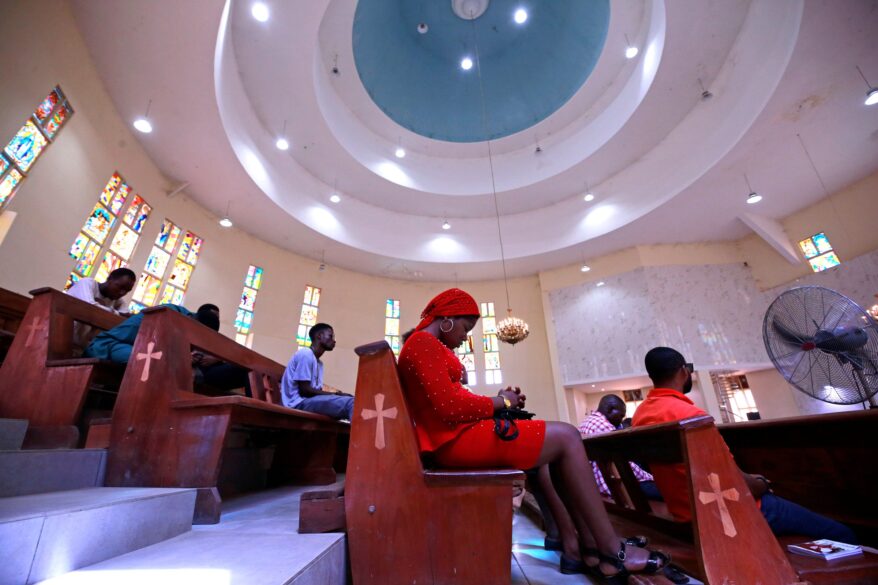
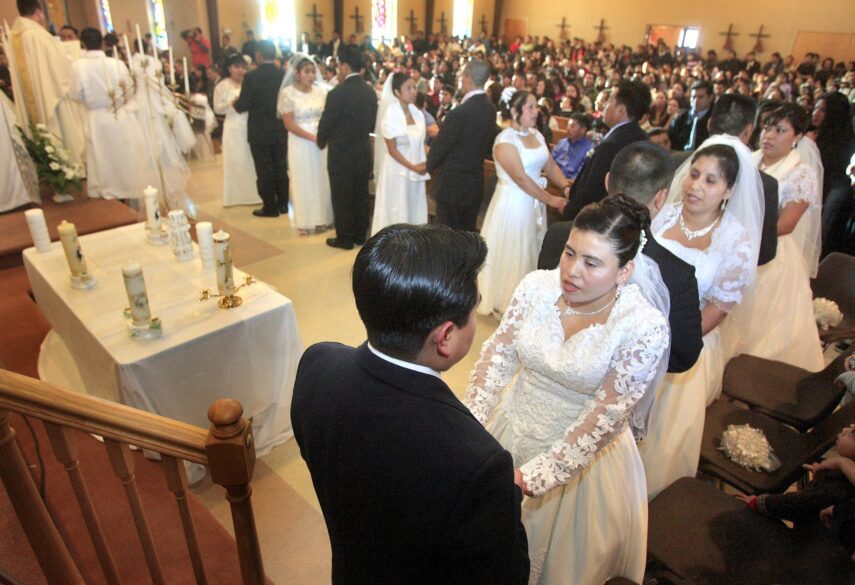
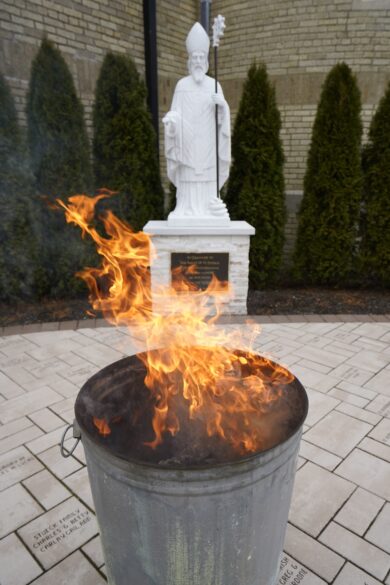

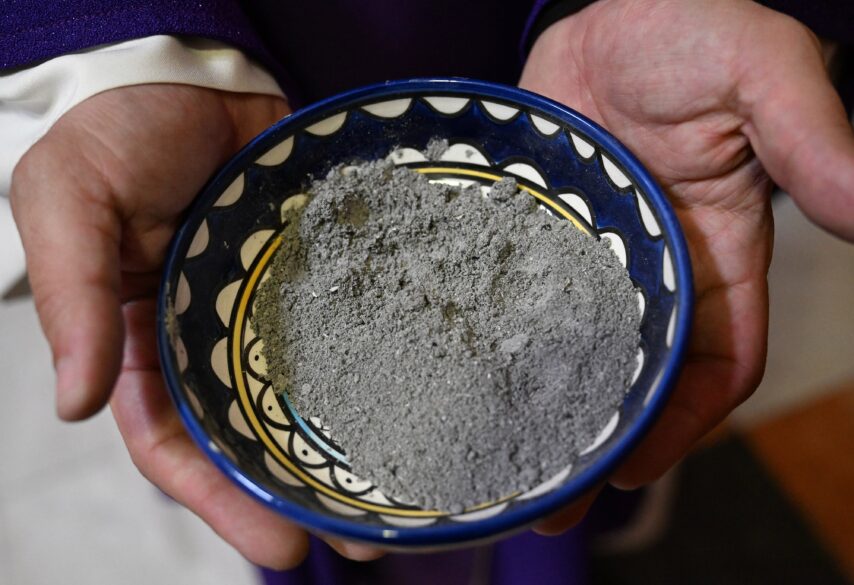





By Kimberley Heatherington
(OSV News) – “It is a scandal,” Pope Francis said in his 2013 message for World Food Day, “that there is still hunger and malnutrition in the world!”
The pontiff further warned against acceptance of that lethal truth, cautioning that “hunger and malnutrition can never be considered a normal occurrence to which one must become accustomed, as if it were part of the system. Something has to change in ourselves, in our mentality, in our societies.”
Listeners may readily nod in agreement – while all too easily imagining that Pope Francis was speaking of some distant, developing nation.
But the truth is, even in the United States – the richest country in the world, if ranked by its $26.95 trillion gross domestic product, or GDP – 49 million Americans, one in every six, relied on food assistance from charities in 2022.

During Poverty Awareness Month, OSV News talked with Catholic Charities offices across the country – in Virginia, Mississippi and Nevada – to learn how they help feed a hungry nation.
The Diocese of Arlington, Virginia – just outside the nation’s capital – is home to four of America’s richest locales, in terms of median income: Loudoun, Fairfax and Arlington counties, and the city of Falls Church. It’s a landscape distinguished by large homes, elevated rents and a highly educated workforce.
“But the reality is that – even in this prosperous area of the country, there is significant poverty,” explained Bishop Michael F. Burbidge after he blessed the Catholic Charities of the Diocese of Arlington’s new Alexandria regional office Jan. 5. “There are people who are hungry every day, every night – not knowing where their next meal is coming from. And so, it’s our sacred duty to kind of wake people up a little bit, and say, ‘No – if we’re really looking, the need is apparent.'”
The new regional office – which includes an expanded food pantry and emergency financial assistance services – opened at a time when casual observers might expect the economic gaps apparent during COVID to be mended.
They aren’t.
An estimated 200,000-plus people remain food insecure in the Arlington Diocese, which encompasses 21 counties and seven cities. The three Catholic Charities food pantries and warehouse form an integral part of the more than 50 pantries and various distribution sites located throughout the diocese, all coordinating together to serve the hungry.
More than 59,000 food requests were made during the last year, $2.2 million in food was distributed, and Christ House shelter served 17,627 free evening meals.
“When we tell people within the last year there’s been a 40% increase in the number of people served – that’s a significant number,” Bishop Burbidge said. “Sometimes you get the word out by numbers – the pounds of food that have been delivered. So the good news is that there is a more spacious place to serve even more people. But the sad reality is, the need is just as great, too.”
Synodality, Bishop Burbidge shared, is essential in serving the poor.
“Even though we may have good intentions, if it comes from above – ‘We want to do good works, and this is what we’re going to do’ – it may not be the most effective way of serving. So it must begin with that synodality, that listening,” he explained. “What are the needs – the most critical needs – at this point? And when you hear from the people you’re trying to help, then you’re going to be more effective.”
“When people come into this place,” Bishop Burbidge said of the food pantry, “one of the things that respects the dignity of the human person is that they get a cart – and they choose. That helps uplift the dignity of the person.”
Mississippi – according to the Mississippi Food Network – “has the worst hunger problem in America.” The charity reports almost one in six Mississippians – about 480,600 people – don’t have enough to eat, while more than one in five children (18.8%) frequently go to bed hungry.
Those are all-too-familiar statistics to Chamon Williams, community services manager at Catholic Charities in the Diocese of Jackson, Mississippi, which includes 65 of the state’s 82 counties.
“We’re always looking for different solutions or resources to support the community,” Williams said.
One solution to senior hunger in Natchez – a little over 100 miles from Jackson – is a partnership between Catholic Charities and the Basilica of St. Mary. Each month, seniors in need are offered a box that includes such food staples as meat, vegetables, fruit, sugar, flour and more. An average of 40 boxes are distributed monthly.
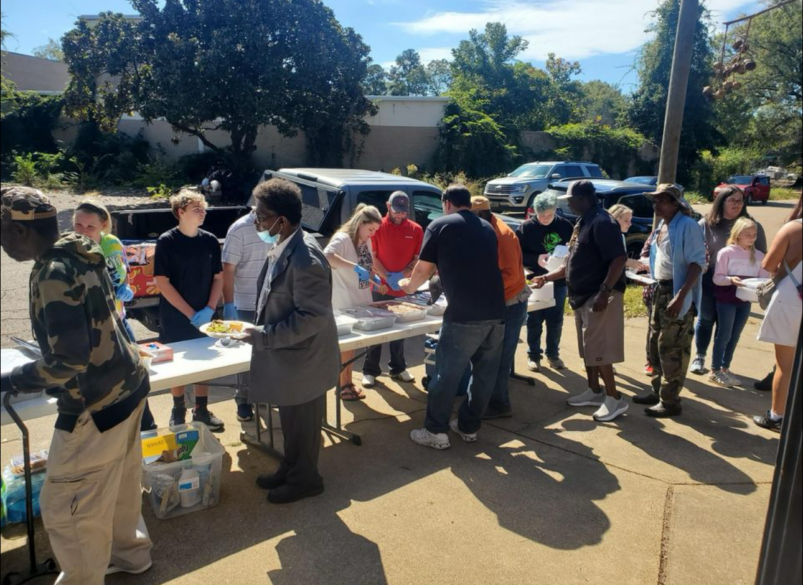
“Because they are on a fixed income,” Williams explained, “the likelihood of many of these individuals receiving SNAP benefits – or even receiving SNAP benefits that would allow them to buy all of the staples that they need on a monthly basis – may be slim, based on their income.” SNAP stands for Supplemental Nutrition Assistance Program, the largest federal food assistance program to people with low incomes.
It’s an awful paradox – numerous of the box recipients are just well enough off, in the government’s assessment, to not receive comprehensive food assistance, but are not well enough off to cover combined costs of rent, medicine and food.
While “what happens in Vegas, stays in Vegas,” those who live in (rather than simply visit) Las Vegas, the most populous city in Nevada, struggle with more than just the lure of the Strip and its casinos. More than 274,000 Southern Nevadans – including one in six children – experienced food insecurity in 2023.
Deacon Tom Roberts – president and CEO of Catholic Charities of Southern Nevada – is uniquely qualified to identify with the needs of his community. During a 30-plus-year executive career in the gaming industry, he was ordained a deacon for the then-Diocese of Las Vegas (now an archdiocese). When his predecessor at Catholic Charities – Msgr. Patrick Leary – died unexpectedly, Deacon Roberts was asked to step in.
He’s been there ever since.
“I like to say, ‘Our clients never expected to be here, and neither did I,'” Deacon Roberts shared, noting Catholic Charities of Southern Nevada has dealt with a “dramatic” rise in food insecurity in the last decade.
The numbers Deacon Roberts cites underscore that assertion: almost 2,500 meals on wheels delivered per day to senior citizens, with another 1,000 on a waiting list; 500-600 community meals served daily; and 150 daily visitors to the community food pantry, open five days per week.
“There’s more need than ever,” sighed Deacon Roberts, who – even as CEO – continues to help deliver meals. Sometimes, what he encounters still has the capacity to shock.
“I’d see the dishes that our food comes in on the floor,” Deacon Roberts recalled, “and I’d say, ‘Why is your dish on the ground? Didn’t you like the food?’ And they’d say, ‘No, deacon – we’re sharing our food with our pets.'”
“And so I’d go out in my car and cry,” the deacon reflected, “and then we started to put donated pet food on our delivery run. Hundreds of our seniors now are as excited and grateful for the food that feeds their companion, so they’re not having to share their food with that pet. It’s been a complete eye-opener for me.”
Deacon Roberts adds, “They’re having to make that sad decision of, ‘Can I afford my rent and my medicine, or do I have food?'”
At the free daily community meal, Deacon Roberts said, “so many of these people we’re serving in that dining room every day are homeless – or as they get towards the end of the month, they just run out of money. Families come in – it breaks my heart to see families and little ones come in.”
Other resources also are available at mealtime, with Deacon Roberts’ staff and volunteers on the lookout to “connect the dots for people.”
“Help and hope” is their mission, according to Deacon Roberts – optimism and assistance for all.
“I like to say we don’t check religious ID cards around here,” Deacon Roberts said. “So anybody that needs help and hope can get it.”
(Kimberley Heatherington writes for OSV News from Virginia.)


February 6
Bishop Joseph R. Kopacz
(ordained bishop)
February 7
Father Hendrik Ardianto, SCJ
Catholic Parishes of Northwest Mississippi
February 14
Father Jofin George
Holy Cross, Philadelphia
February 19
Father Vijaya Bhaskar Madanu, SVD
Holy Ghost & Holy Family, Jackson
Thank you for answering the call!
By Carol Glatz
VATICAN CITY (CNS) – Wrath is a “dark vice” that destroys relationships, focuses all blame on others and only worsens over time, Pope Francis said.
“It is capable of depriving us of sleep, of barring the way to reason and thought” because wrath completely clouds thinking clearly and builds up incessantly without mercy, the pope said Jan. 31 at his weekly general audience in the Paul VI Audience Hall.
Continuing a series of audience talks about vices and virtues, the pope reflected on the vice of wrath.
“If it is born of an injustice suffered or believed to be suffered, often it is unleashed not against the offender, but against the first unfortunate victim,” he said, giving as an example people who can “withhold their rage in the workplace,” but then unleash it at home on their spouse and children.
Wrath “destroys human relationships. It expresses the incapacity to accept the diversity of others, especially when their life choices diverge from our own,” he said.
When someone is dominated by wrath, the pope said, “they always, always say the problem is the other person; they are unable to recognize their own defects, their own shortcomings.”
St. Paul recommends Christians face up to the problem right away and attempt reconciliation before the end of the day, the pope said, quoting the apostle’s Letter to the Ephesians (4:26) “Do not let the sun set on your anger.”
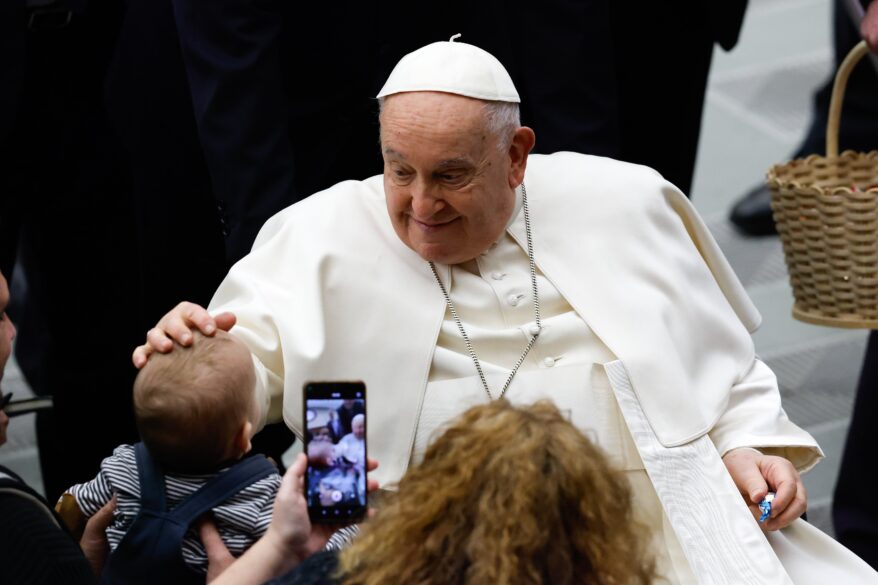
“The night cannot be handed over to the devil,” the pope said, repeating that it is important that any misunderstandings be handled before the day is over since this vice can keep people “awake at night, brooding over our reasons and the unaccountable mistakes that are never ours and always the other’s.”
“In the Lord’s Prayer, Jesus makes us pray for our human relations, which are a minefield: a plane that is never in perfect equilibrium,” he said.
“We are all sinners, all of us,” with outstanding debts or “trespasses” committed and experienced throughout life, he said.
“Therefore, we all need to learn how to forgive” as far as humanly possible, he said. “Wrath is countered by benevolence, openness of heart, meekness and patience.”
However, the pope said, “not everything that stems from wrath is mistaken.”
“We are not responsible for the onset of wrath, but always for its development,” he said.
Sometimes “it is good for anger to be vented in the right way,” he said. “Holy indignation exists,” especially at an injustice, but this is not wrath.
Jesus felt it several times in his life, but “he never responded to evil with evil,” the pope said.
When he entered the temple and drove out the merchants and overturned the tables of the money changers, Jesus “performed a strong and prophetic action, dictated not by wrath, but by zeal for the house of the Lord,” he said.
“We need to distinguish the good,” which is holy indignation, he said, from the bad, which is wrath, and to pray to correctly govern one’s passions, “to educate them so that they turn to the good and not the bad.”
The pope also recalled Jan. 31 was the feast of St. John Bosco.
In his greetings to visitors in other languages, the pope highlighted the work of the 19th-century Italian saint, saying he helped many young people in their difficulties and, with his apostolic zeal, brought them to Christ. “Let us also be witnesses to young people that Christ wants to enter our lives to fill them with the joy that only he can give.”
He invited people to imitate the saint, “educating young people in the faith and training them in the different sciences and professions, for a better future in which humanity can enjoy peace, brotherhood and tranquility.”
Guest Column
By Sister Hosea Rupprecht
Season four of “The Chosen,” the wildly popular series on the life of Jesus that began its existence as a crowd-funded streaming series, is finally here, much to the delight of fans around the world. This time around, all episodes will enjoy a theatrical release before debuting on streaming and broadcast outlets.
At nearly the same time as season four is released, Catholics begin the liturgical season of Lent. “The Chosen” provides much inspiration that could kick start your Lenten reflection on how God might be inviting you to metanoia, or conversion, during this penitential season.
The first episode deals with the death of John the Baptist (David Amito) and the fallout of that for Jesus (Jonathan Roumie) and the apostles, especially Andrew (Noah James), one of John’s early followers. John’s faithfulness to his God-given vocation, even through imprisonment and death, encourages us to reflect on our own responses to God’s invitations. How have we responded to God’s prompting? How do we even recognize how God summons us to follow him on a daily basis? Are we courageous in the face of persecution, whatever form that may take, or do we shrink from it?

In episode two, things heat up for Jesus following John’s execution. More than that, though, there is dissension in the ranks when Jesus declares that Simon (Shahar Isaac) is no longer Simon but Peter, the rock upon which his church will be built. That night around the campfire, the apostles start to bicker with comments like, “Is Peter the best?” and “He doesn’t act like a rock.” Have you ever felt disappointed in those in leadership positions? How did you respond? What place does humility have in your life? How might God be inviting you to deepen your humility?
Fans of the show will remember that Matthew (Paras Patel) is depicted as having some form of autism. He’s extremely precise – that made him a good tax collector – and he really doesn’t like physical contact. There’s a small scene in episode two when Matthew encounters his old friend, the Roman, Gaius (Kirk B.R. Woller). Gaius observes that Matthew seems different, more relaxed and at peace. Matthew’s response is all about trust in Jesus and surrender to God’s will. He says, “I have only one thing to do today: Follow him. The rest takes care of itself.” What if every Christian could have that attitude? What would happen if we could let go of the problems that worry us and give them all over to God? Is there one thing in my life right now that I need to let go of and relinquish to God? How might I do that this Lent?
Lent is a time to think about the need for reconciliation and forgiveness. In “The Chosen,” the ongoing tension between Matthew and Simon (now Peter) started way back when Matthew almost turned Peter over to the Romans for unpaid taxes. Matthew has never apologized for his actions, and Peter holds onto his resentment. With hostility increasing all around them, Matthew feels unsettled and seeks out Jesus. Jesus helps him to see the need to own up to his actions and reach out to Peter. Jesus tells Matthew that one apologizes to repent, but that forgiveness is a gift from another person. It cannot be demanded.
The thing is, neither Matthew nor Peter is ready to reconcile. Jesus is gentle in his prodding saying, “There is no peace when two of my followers hold resentment against one another.” Since there are over 2 billion Christians in the world, it can be assumed that there are enough resentments to displace the peace that comes with following Jesus. What is one resentment that you could let go of this Lent? Do you need to apologize to anyone? Do you have the power to offer the gift of forgiveness to someone who has hurt you? What’s holding you back?
Yes, “The Chosen” is a made-up television series and not the Gospel itself. Yet, the power of media stories is that they show real, flawed humans, just like you and me, interacting in an imaginative way. “The Chosen,” in particular, can inspire us to take what we see on screen and prompt us to look at our inner selves and the quality of our own following of Christ, especially during this Season of Lent.
(Sister Hosea Rupprecht, a Daughter of St. Paul, is the associate director of the Pauline Center for Media Studies.)
GUEST COLUMN
By Silvio Cuéllar
This February, we celebrate Valentine’s Day, the day of love and friendship. February 14 is also Ash Wednesday, the beginning of Lent. At first glance, many will think that we will not be able to celebrate with our partners, but there are interesting parallels between true love as a couple and Lent. During Lent, we focus mainly on three important things: prayer, fasting and charity. Likewise, to have a successful and holy marriage, it is also required to have a prayer life with Christ at the center, make many sacrifices and be generous in giving ourselves to our family as Christ offered up himself for the church.
—Prayer—
Prayer is essential for a Catholic home and a couple’s relationship to last and bear much fruit. When we look at the lives of the saints, many were the fruit of their parents’ lives of prayer.
We have the example of St. Monica, mother of St. Augustine, who persevered in prayer for many years for the conversion of her son, who, despite having had a non-exemplary life, decided at one point to embrace the faith, becoming a doctor of the church.

My in-laws, Paul and Barbara, are examples of prayer, sacrifices and charity. I have always admired their great faith and commitment to serving others. They adopted a child from the foster care system and, over the years, helped many single mothers financially. From them, I learned what it means to live the faith, not just in the parish, but Monday through Sunday. I remember that, at every family gathering, they would begin with a family prayer. They always led by example and never missed going to church.
One suggestion during this Lent would be to take on (or pick back up) the practice of praying the rosary as a family, giving the children the opportunity to lead a decade. Let us remember that “The family that prays together, stays together.”
—Sacrifices—
For Catholics, Ash Wednesday and Good Friday are obligatory days of fasting and abstinence. Likewise, the Fridays of Lent are days of abstinence; on those days, we abstain from eating meat. That may not be a sacrifice for you so there are many other ways in which we can practice sacrifice and fasting. For example, we can fast by limiting or eliminating social media and technology use during the 40 days of Lent.
Sacrifice is also very important for a couple. Spouses should love and make sacrifices for each other as Christ sacrificed himself for the church. This concept goes against the modern culture of instant gratification, where the “I” comes first.
At the beginning of a marriage, we go through the honeymoon or infatuation stage, where everything is rose-colored. Then comes the maturity stage, where every day we make the decision to love the person God has placed in our lives. That implies making sacrifices for the sake of our partner and family, putting them ahead of our needs.
I remember recently, the night after a very exhausting weekend, I was very tired on my way to bed when I received a call from my son at 10:30 p.m. He was at the gym and had no way to get home. Even though my body was telling me to go to bed, without a moment’s hesitation, I answered, “I will be there in 15 minutes.” As parents, we may have countless examples of how we have sacrificed for our children, including our time and income.
Another important way to make sacrifices and an excellent investment is, for example, to enroll our children in a Catholic school, where they can receive an excellent education and formation in the faith. I sometimes joke that I could be driving a luxury car with what I pay for my daughter in high school. But the truth is that as parents we know that any material sacrifice is not enough to give the best to our children.
—Charity—
Finally, Lent is a time to practice charity more intensely.
Many of our parishes participate in Catholic Relief Services’ Rice Bowl campaign to support the efforts of the U.S. bishops’ international relief agency, which helps the world’s most disadvantaged with development programs and emergency assistance. Diocesan Service Appeal campaigns also help fund diocesan ministries and local relief. Let us be generous with these opportunities and offer our generosity in our parish community.
In married life, we can focus on giving more of our time this Lent, seeking to strengthen the relationship between spouses and with our children by being more present in their lives and activities.
We can also make time to reconnect with family members with whom we have not spoken for a long time, call them to reconcile, ask forgiveness if we have offended them, give them a word of support and offer to pray for them.
This Lent, let us seek to focus on habits of prayer, fasting and charity, using our resources, time, treasure and talents to volunteer in ministries that serve and help others.
(Silvio Cuéllar is a liturgical music composer and journalist. He is a former coordinator of the Hispanic Ministry and editor of El Católico de Rhode Island newspaper in the Diocese of Providence.)
From the Archives
By Mary Woodward
JACKSON – Last Saturday, Jan. 27, was a cloudy damp day in the Mississippi Delta, but the joy and the warmth flowing from the pews filled with the faithful and friends of Our Mother of Mercy Mission in Anguilla dispelled any thoughts of the atmospheric conditions outside. The church was marking the 100th anniversary of the first Masses celebrated in people’s homes.
Anguilla is situated on Highway 61 in Sharkey County. In the early 1900s, Father Andrew Gmelch would come from Merigold. Father Gmelch served the Austrian Catholic farmers in that town, but the continual flooding challenges caused this small contingent of Catholic farmers to move away. Around 1912 Anguilla became a mission of Cleveland and Belzoni All Saints became a mission of Greenwood where Msgr. John Clerico, known as the pastor of the Delta, based himself.
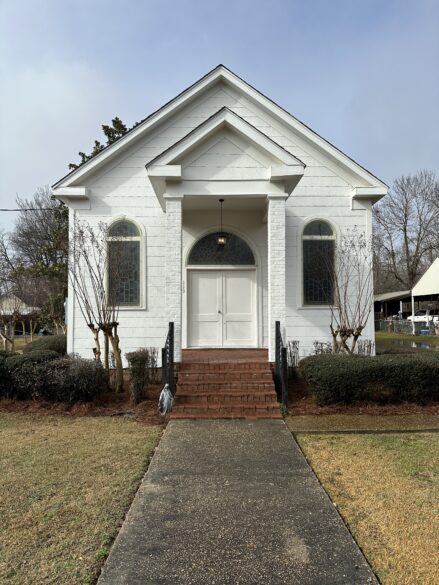
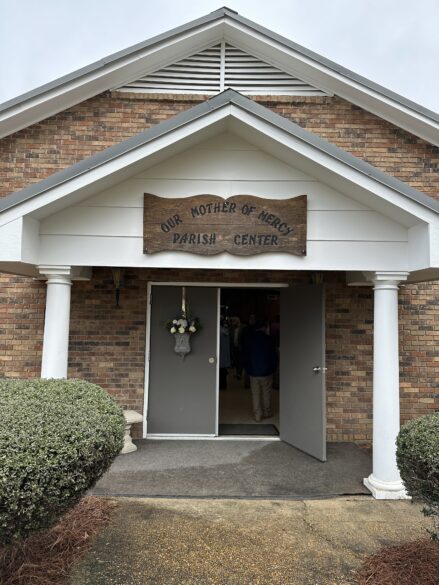
Msgr. Clerico roamed the entire Delta tending to the flock scattered across the Alluvial plain. In 1927, Anguilla became a mission of Greenwood and Msgr. Clerico made regular visits to celebrate Mass in homes of the faithful and share meals and conversations in Italian with those who shared his Italian heritage and birth.
With donations from its faithful and a nice grant from Catholic Extension, Anguilla bought a small piece of land in March 1929 and built Our Mother of Mercy Church. Bishop Richard Gerow dedicated the church on Aug. 6, 1929.
Belzoni and Anguilla became missions of Leland in 1944 when Msgr. Clerico’s Greenwood parish was divided. A few years later in 1953, Belzoni was elevated to a parish and Anguilla became its mission. Today, Anguilla is served by Father Panneer Arockiam Selvam from Yazoo City.
This is a brief history of Our Mother of Mercy and its journey taken from Cleta Ellington’s book Christ the Living Water written for the 150th anniversary of the diocese in 1987. These excerpts capture only a small glimpse of the closeness of this small Catholic community in the Delta.
To get an eyewitness account of the dedication day festivities, I looked up Bishop Gerow’s account of the day in his diary and below is his entry for Aug. 6, 1929.
“This morning at 9 o’clock, assisted by Father Clerico and in the presence of a large number of people, I dedicated the new Church of Our Lady of Mercy at Anguilla.
“The lot on which this church is situated was bought with funds raised by the people of Anguilla and thereabout. Extension Society gave the people $2,500 for the building of the church and $400 worth of equipment, vestments, etc. It is quite a nice little church and substantially built, and the people are very justly proud of it.
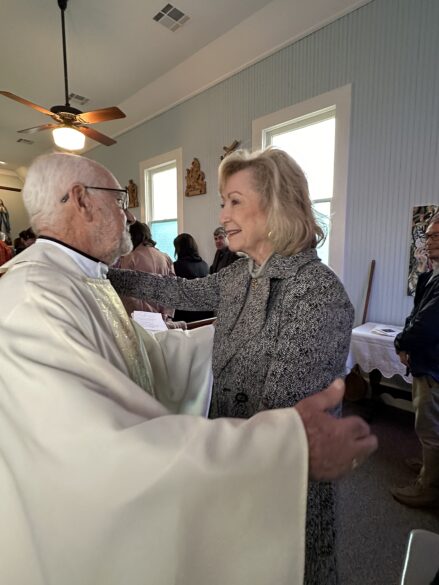
“Joe Prestiano, a zealous and enthusiastic member of the congregation at Anguilla, was determined to make this a big day. He had, therefore, advertised it very extensively. Through his efforts the Knights of Columbus band came up from Vicksburg for the occasion. Father Clerico brought his Greenwood choir over and a great many friends from Vicksburg, Greenville, Greenwood and surrounding cities and towns were in Anguilla for the dedication; besides a great number of the faithful from the small towns who will attend Anguilla as their mission church.
“The dedication started at 9 o’clock. A procession formed at the home of Mr. and Mrs. Cook, headed by the Knights of Columbus band playing lively march music – the procession made up of the men of the congregation and a few altar boys, with Father Clerico, and the Bishop dressed in cope, miter and carrying his crozier – and marched to the front of the church.
“After the dedication Father Clerico sang the high Mass – the Greenwood choir did itself proud – and the bishop preached a sermon to the people; and after the church ceremonies a general picnic was held, the people remaining upon the grounds all day, the Knights of Columbus band supplying very good music for the occasion. It was a great day for the people of Anguilla.
“Although the congregation of Anguilla itself is very small, yet Anguilla is centrally situated and people from many other places, such as Rolling Fork, Hollandale, etc., come to church at this point.”
I was struck by how much of that same zeal and flavor was present this past Saturday in January.
Bishop Joseph Kopacz was the celebrant; Father P.J. Curley, former pastor, provided an inspiring homily only he could deliver; several former pastors were present; friends came from all over the region; and the reception after Mass in the parish hall (now occupying those original grounds) was adorned with fabulous food, fellowship and memories – a quintessential Delta brunch.
Even though there was no Knights of Columbus Band or big choir, those present filling the church to capacity offered beautiful hymns, prayers and responses of which they could be proud. I find I am as inspired by these celebrations in smaller communities as much as any Cathedral Mass. The love and joy that flows in and around the sacred mysteries is a powerful witness to the vibrancy of our faith in the diocese. Who knows what the landscape will be in another 100 years, but on a cloudy day in January 2024, Anguilla bore witness to that vibrant faith.
(Mary Woodward is Chancellor and Archivist for the Diocese of Jackson.)
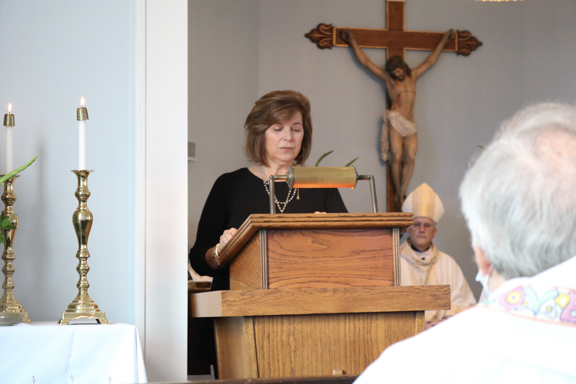


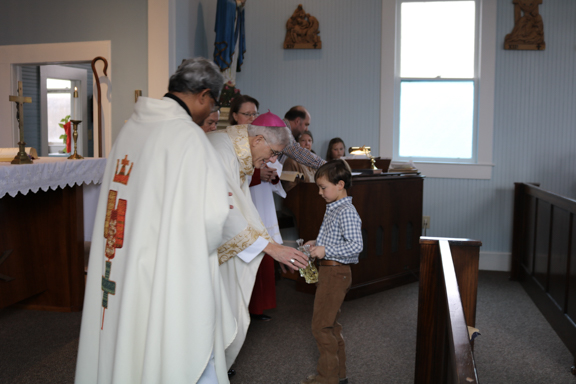
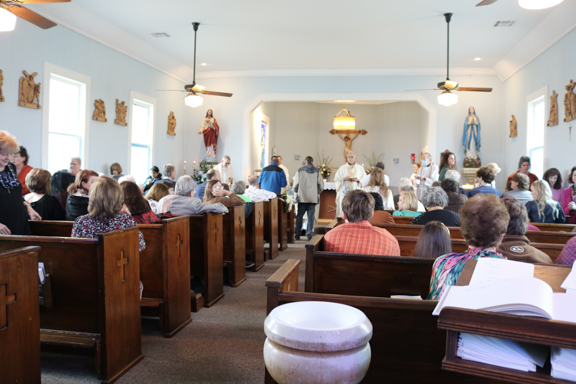
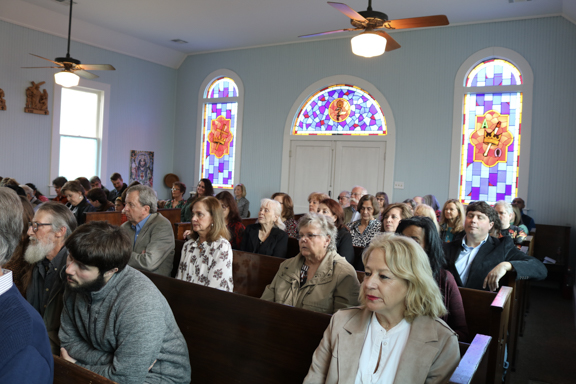
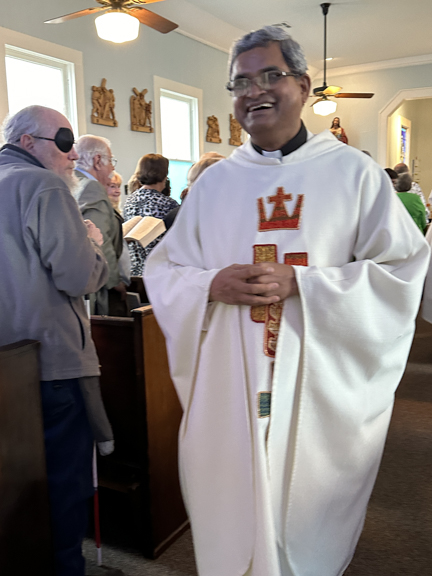

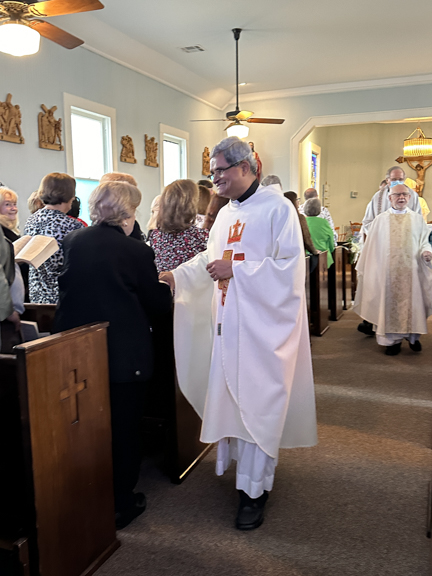
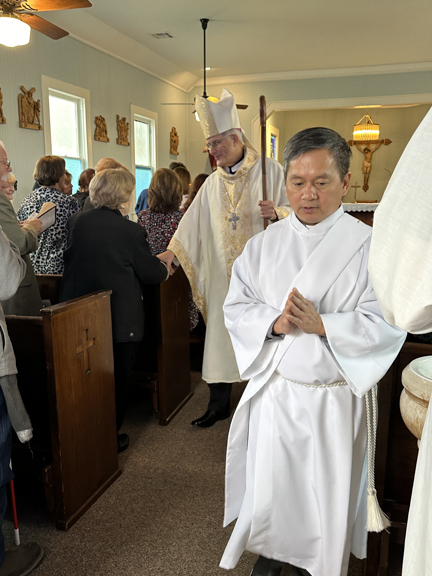
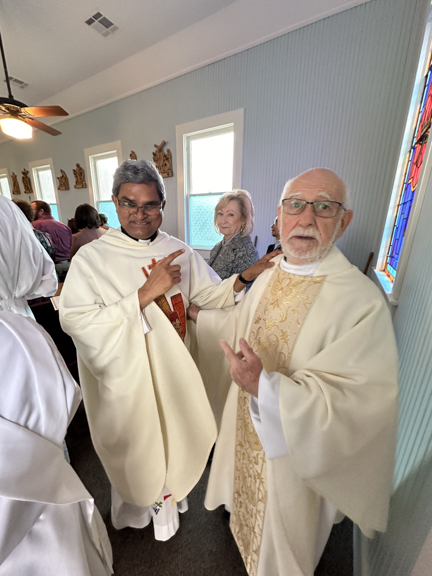
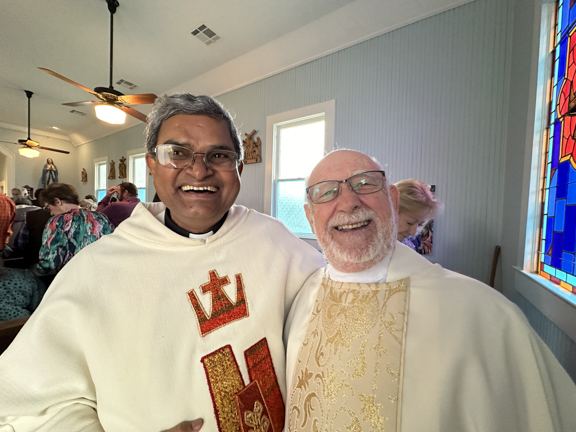
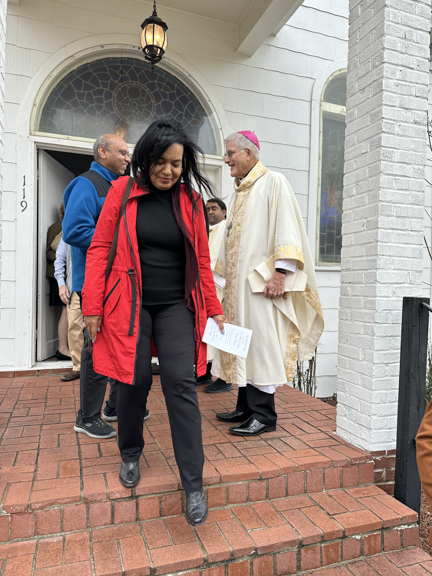
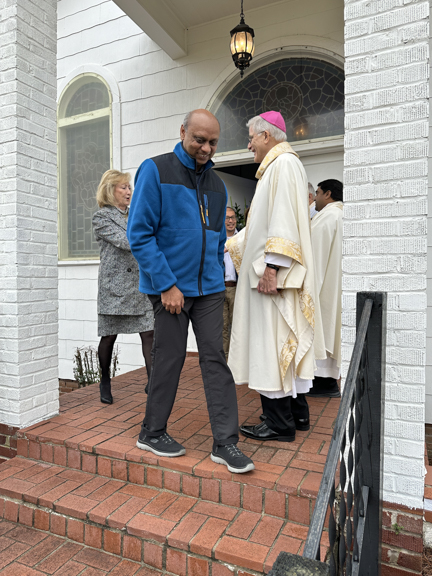
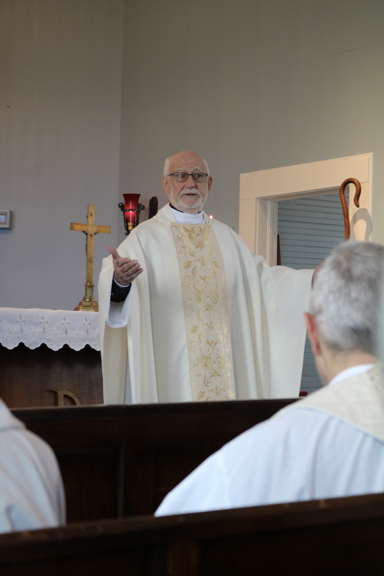
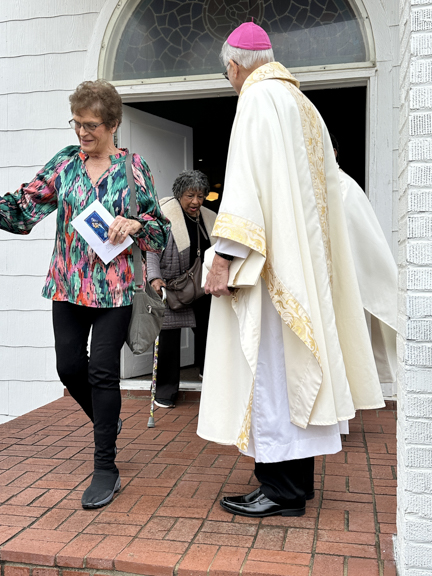
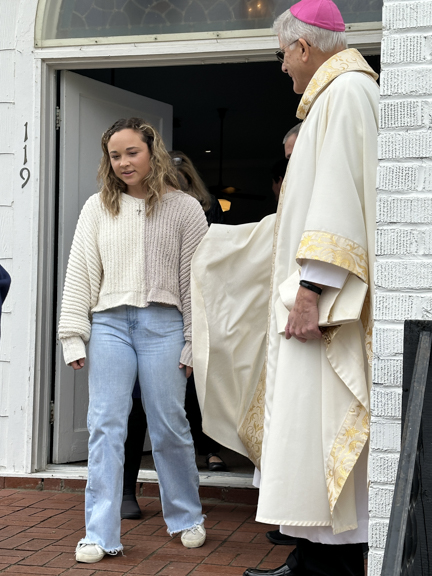
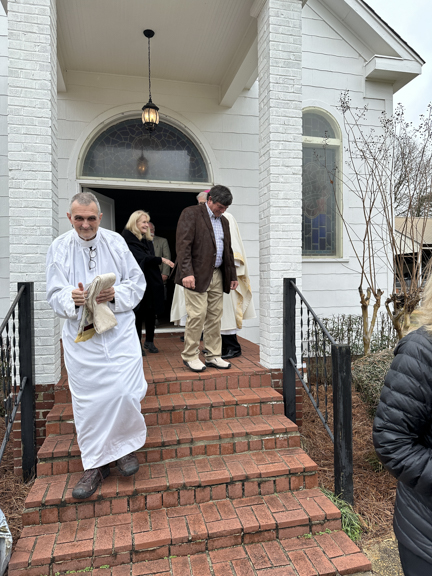
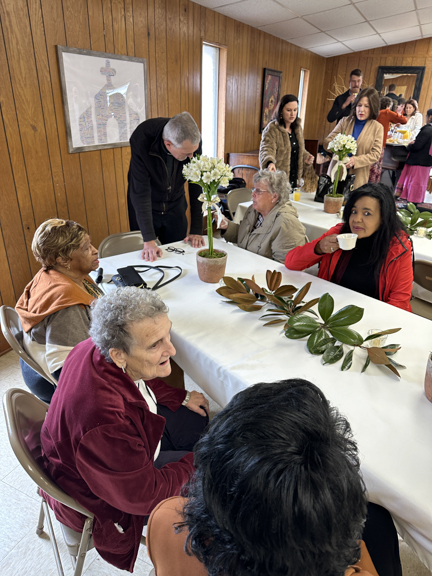
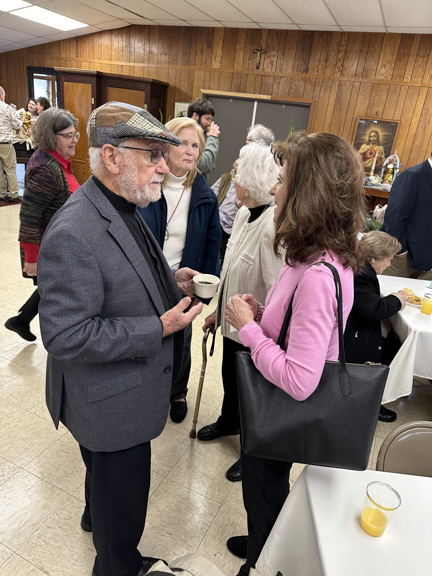


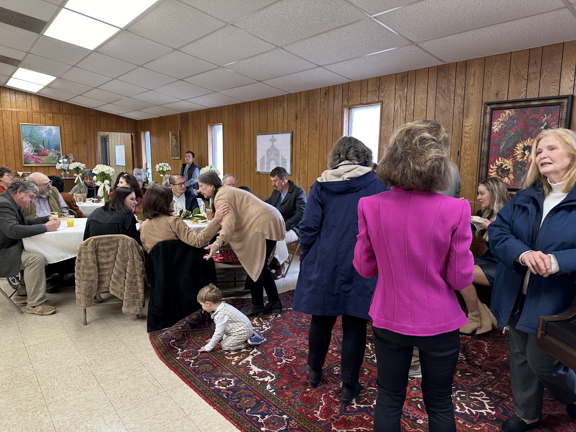

By D.D. Emmons
(OSV News) – Among the beautiful, meaningful and solemn ceremonies of the Catholic Church is the gathering of the faithful on Ash Wednesday.
This special day begins our Lenten journey. It is the start of 40 days of prayer, penance and almsgiving as we prepare ourselves to celebrate the resurrection of our Lord Jesus Christ on Easter Sunday. But why does Lent begin on a Wednesday, and what is the significance of ashes?
Ash Wednesday was added to the liturgical calendar well after the 40-day penitential season of Lent became the norm throughout the Latin Church. Lent, in turn, was universally established only after the early church sorted out the date of Easter. The issue was clarified at the famous Council of Nicaea in 325 where “all the Churches agreed that Easter, the Christian Passover, should be celebrated on the Sunday following the first full moon (14 Nisan) after the vernal equinox.” (Catechism, No. 1170) The vernal (spring) equinox generally falls on March 21, thus the date of Easter in the Western Church can occur anytime between March 22 and April 25.
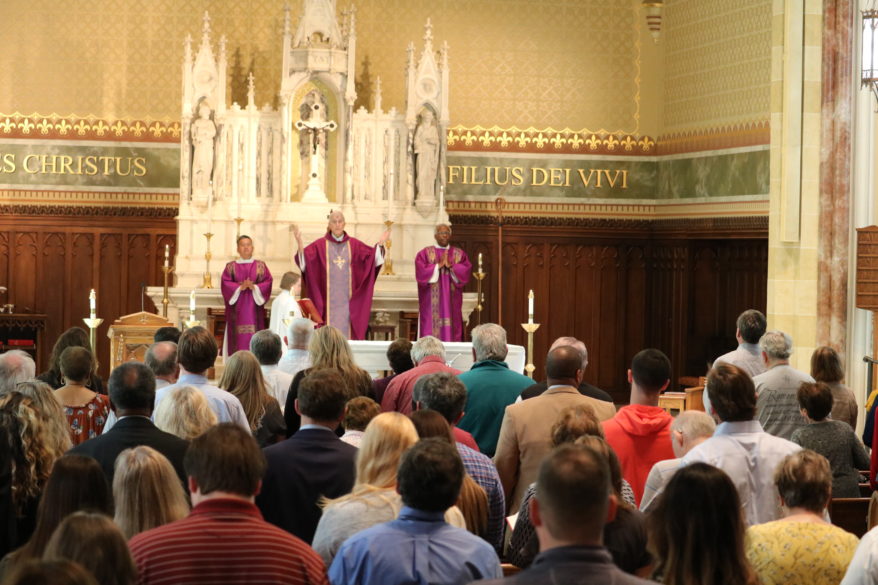
The word “Lent” is from an Old English term meaning “springtime,” and by the second century the term was being used to describe the period of individual fasting, almsgiving and prayer in preparation for Easter. Among the Christians of the first three centuries, only those aspiring for baptism – the catechumens – observed a defined period of preparation, and that time lasted only two or three days.
The idea of Lent being 40 days in length evolved over the next few centuries, and it is difficult to establish the precise time as to when it began. Among the canons issued by the Council of Nicaea, the church leaders, in Canon Five, made reference to Lent: “and let these synods be held, the one before Lent that the pure gift may be offered to God after all bitterness has been put away, and let the second be held about autumn.” The language of this canon seems to validate that Lent, in some fashion, had by the fourth century been established and accepted by the church. While the exact timing and extent of Lent both before and after the Nicaea council is unclear, what is clear from historical documents is that Christians did celebrate a season of Lent to prepare themselves for Resurrection Sunday and used a variety of ways to do so.
That Lent evolved into a period of 40 days in length is not surprising, as there are numerous biblical events that also involved 40 days. Moses was on Mount Sinai receiving instructions from God for that number of days (see Ex 24:18); Noah and his entourage were on the Ark waiting for the rains to end for 40 days and 40 nights (Gn 7:4); and Elijah “walked forty days and forty nights to the mountain of God, Horeb.” (1 Kgs 19:8)
Mostly, though, the 40 days of Lent identify with the time our Lord Jesus spent in the desert fasting, praying and being tempted by the devil. (Mt 4:1-11) “By the solemn forty days of Lent the Church unites herself each year to the mystery of Jesus in the desert.” (Catechism, No. 540)
There is, therefore, evidence that by the end of the fourth century Christians were participating in a 40-day Lent before Easter. The dilemma now became how to count the 40 days. In the Latin Church, six weeks were used to identify the Lenten period, but one doesn’t fast on Sundays, so six Sundays were subtracted and there remained only 36 fasting days. In the early seventh century, St. Pope Gregory I the Great (pope from 590-604) resolved this situation by adding as fast days the Wednesday, Thursday, Friday and Saturday before the first Sunday of Lent. Thus the Lenten 40-day fast, or the Great Fast as it was known, would begin on a Wednesday.
Initially, people fasted all 40 days of Lent. They ate one meal a day and only an amount of food that would sustain survival. But the church taught, and people believed (then as now), that fasting is not about what we eat, it is about changing hearts, interior conversion, reconciliation with God and others. It’s about living in an austere way, giving from our abundance to the poor. St. John Chrysostom (347-407) explained it this way: “Do you fast? Give me proof of it by your works! … If you see a poor man, take pity on him! If you see an enemy, be reconciled to him! If you see a friend gaining honour, envy him not! If you see a handsome woman, pass her by!” (Homily on the Statutes, III.11)
The church has long used ashes as an outward sign of grief, a mark of humility, mourning, penance and morality. The Old Testament is filled with stories describing the use of ashes in such a manner. In the Book of Job, Job repented before God: “Therefore, I disown what I have said, and repent in dust and ashes.” (42:6) Daniel “turned to the Lord God, to seek help, in prayer and petition, with fasting, sackcloth and ashes.” (Dn 9:3) Jonah preached conversion and repentance to the people of Nineveh: “When the news reached the king of Nineveh, he rose from his throne, laid aside his robe, covered himself with sackcloth, and sat in the ashes.” (Jonah 3:6) And the Maccabees army prepared for battle: “That day they fasted and wore sackcloth; they sprinkled ashes on their heads and tore their garments.” (1 Mc 3:47)
Ashes were imposed on the early catechumens when they began their preparation time for baptism. Confessed sinners of that era were also marked with ashes as part of the public penitential process. Other baptized Christians began asking to receive ashes in a manner similar to catechumens and penitents. Christian men had ashes sprinkled on their heads while ashes were used to trace the cross on the forehead of women. Thus the use of ashes as the sign of penance, in readiness for Easter, was becoming a churchwide practice.
During the papacy of St. Gregory the Great, the practice was further expanded and is mentioned in the sixth-century Gregorian Sacramentary. Around the year 1000, Abbot Aelfric of the monastery of Eynsham, England, wrote: “We read in the books both in the Old Law and in the new that men who repented of their sins bestowed on themselves with ashes and clothed their bodies with sackcloth. Now let us do this little at the beginning of our Lent, that we strew ashes upon our heads, to signify that we ought to repent of our sins during the Lenten feast.” This same rite of distributing ashes on the Wednesday that begins Lent was recommended for universal use by Pope Urban II at the Synod of Benevento in 1091.
So when we go to that early Mass on Ash Wednesday morning and receive the blessed ashes on our forehead, we are repeating a somber, pious act that Catholics have been undergoing for over 1,500 years. As “The Liturgical Year, Septuagesima,” by the Benedictine Abbot Gueranger, written in the middle decades of the 1800s, puts it: “We are entering, today, upon a long campaign of the warfare spoke of by the apostles: forty days of battle, forty days of penance. We shall not turn cowards, if our souls can but be impressed with the conviction that the battle and the penance must be gone through. Let us listen to the eloquence of the solemn rite which opens our Lent. Let us go whither our mother leads us, that is, to the scene of the fall.”
Like all those before us, we unhesitatingly embrace this invitation to sanctity, this time to turn away from sin. We are part of that great cloud of witnesses who through all the ages have donned the ashes, publicly acknowledging that we are Christians, Christians who have sinned and seek to repent. We acknowledge that “we are dust and to dust we shall return.”
(D.D. Emmons writes from Pennsylvania.)
By Sandy Cunningham
SAINT BENEDICT, La. – A group of seminarians from St. Joseph Seminary College won the 22nd annual Father Pat O’Malley Invitational basketball tournament in Mundelein, Illinois, this past weekend. It is the second straight year the team has won the tournament, which brings seminarians from around the country together to compete on the hardwood.
St. Joseph Seminary swept through pool play with wins over Mount Saint Mary’s Seminary (Athenaeum) from Cincinnati, 61-38, host Mundelein Seminary, 49-39 in overtime, and St. John Vianney Theological Seminary of Denver, 54-49. The Ravens defeated Mundelein in the semifinals, 35-30, to advance to Sunday’s championship game, where they beat Conception College Seminary of Conception, Missouri, 75-62.
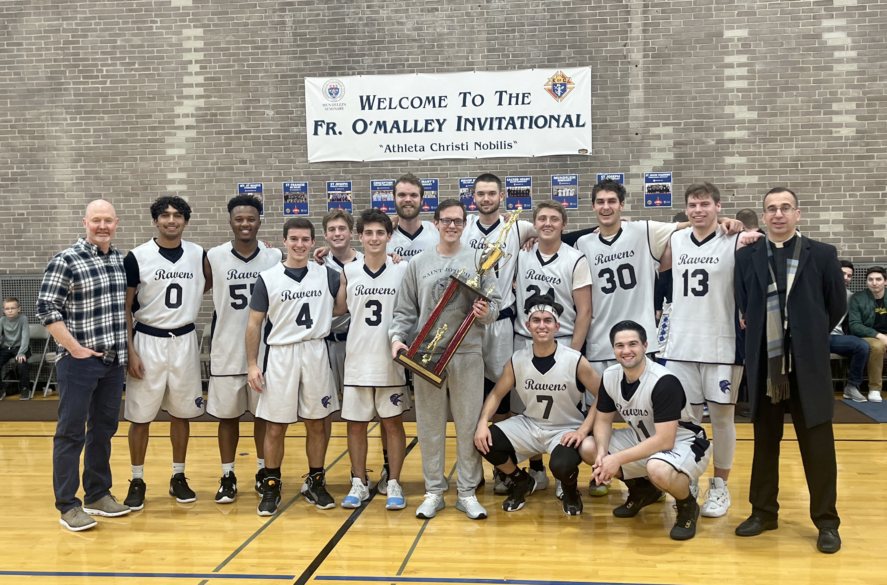
Team members are Ethan Green, Thomas Benson, Michael Bradford, Tim Talbott and Joey Piccini, Archdiocese of Mobile; Grayson Foley and Francisco Maldonado, Diocese of Jackson; Evan Lang and Jacob Zimmerer, Diocese of Fort Worth; Emmanuel Legarreta, Diocese of El Paso; and Carter Domingue and Logan Simon, Diocese of Lafayette. Zach Jolly (Saint Joseph Abbey) assisted the team, coached by Brian Cochran. Father Maurice Moon served as team chaplain.
Domingue, who scored 32 points in the championship game, was named the tournament’s Most Valuable Player.
(Sandy Cunnuingham is the communications and marketing manager for St. Joseph Seminary College in St. Benedict, Louisiana.)